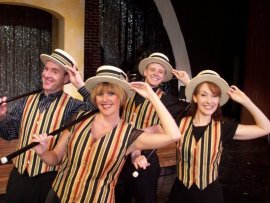An actor friend of mine says he always wants to be the worst performer in everything he's in, because if the rest of the cast is doing stronger work than he is, that means the show is in really, really good shape. With that in mind, any actor worth his or her salt would be thrilled to be the worst performer among these five ensembles.
Are We There Yet?. Circa '21 rarely produces a musical featuring fewer than half a dozen performers, but the combined talents of Erin Churchill (nee Dickerson), Sandra D. Rivera, Tristan Tapscott, and Tom Walljasper here made it seem as though dozens were sharing the stage simultaneously. The show's musical vignettes on growing up and growing old were perfectly charming; the cast - each assuming a number of character roles, and acting and singing everything from high comedy to tearful sentiment - was simply perfect.
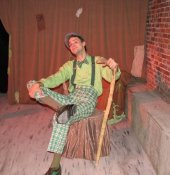 A Year with Frog & Toad. A pox on the Green Room and its one-weekend runs! I'm kidding, of course, but I sure wish more people had the opportunity to catch this wonderfully heartfelt and funny family musical, which found Chris Walljasper and Jeremy Stump giving delightful storybook performances as amphibian best friends, and James Bleecker, Melissa Anderson Clark, Catie Osborn, and the preternaturally gifted Lauren Van Speybroeck offering stellar support. If this group can be rounded up again at some point down the road, I'm thinking a revival's in order.
A Year with Frog & Toad. A pox on the Green Room and its one-weekend runs! I'm kidding, of course, but I sure wish more people had the opportunity to catch this wonderfully heartfelt and funny family musical, which found Chris Walljasper and Jeremy Stump giving delightful storybook performances as amphibian best friends, and James Bleecker, Melissa Anderson Clark, Catie Osborn, and the preternaturally gifted Lauren Van Speybroeck offering stellar support. If this group can be rounded up again at some point down the road, I'm thinking a revival's in order.
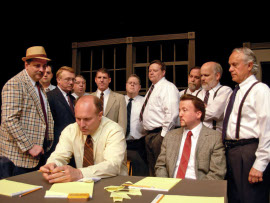 12 Angry Men. One of theatre's all-time great ensemble dramas was, at Playcrafters, performed by one of the area's all-time great male ensembles, an inspiring gathering that included (in order of juror number) Bill Bates, Joe Mital, Jerry Wolking, Chris Browne, William Pepper, Joshua Kahn, Bill Hudson, James V. Driscoll, Spiro A. Bruskas, Tom Morrow, Michael B. Miller, and Don Hazen, with Don Madson as the jury-room guard. Some had more material to work with than others, but none appeared to be having less than a really good time.
12 Angry Men. One of theatre's all-time great ensemble dramas was, at Playcrafters, performed by one of the area's all-time great male ensembles, an inspiring gathering that included (in order of juror number) Bill Bates, Joe Mital, Jerry Wolking, Chris Browne, William Pepper, Joshua Kahn, Bill Hudson, James V. Driscoll, Spiro A. Bruskas, Tom Morrow, Michael B. Miller, and Don Hazen, with Don Madson as the jury-room guard. Some had more material to work with than others, but none appeared to be having less than a really good time.
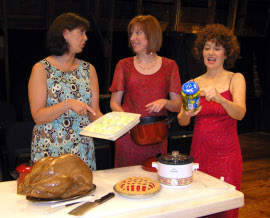 Dearly Beloved. Richmond Hill's best time this year was, for me, provided by the happy eccentrics in this Southern-fried wedding comedy. Diane Greenwood, Lorrie Halsall, and Valerie Pieper were touching and radiantly nutty as a trio of squabbling sisters, and Eugenia Giebel, Larry Lord, Kady Patterson, Susan Philhower, Carla Stevens, Nicholas Waldbusser, Stan Weimer, and Archie Williams added significantly to the anything-goes merriment. The production's first line got a laugh, the curtain call got a laugh (the double-cast Patterson was deservedly allowed two bows), and the laughter in between rarely waned.
Dearly Beloved. Richmond Hill's best time this year was, for me, provided by the happy eccentrics in this Southern-fried wedding comedy. Diane Greenwood, Lorrie Halsall, and Valerie Pieper were touching and radiantly nutty as a trio of squabbling sisters, and Eugenia Giebel, Larry Lord, Kady Patterson, Susan Philhower, Carla Stevens, Nicholas Waldbusser, Stan Weimer, and Archie Williams added significantly to the anything-goes merriment. The production's first line got a laugh, the curtain call got a laugh (the double-cast Patterson was deservedly allowed two bows), and the laughter in between rarely waned.
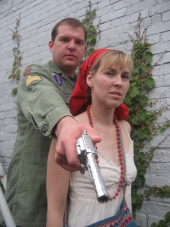 Assassins. The Green Room's Carousel for 2008, this dazzling interpretation of a classic musical found Stephen Sondheim's stunner of a score (and John Weidman's lip-smacking dialogue) brought to wicked life by Michael Callahan, Melissa Anderson Clark, Wendy Czekalski, Louis Hare, Jackie Madunic, Curtis Oelschlaeger, Mark and Linda Ruebling, Jonathan Schrader, Eddie Staver III, David Turley, and Ryan Westwood. Originally scheduled for two weekends, Assassins was extended to three. Looking over that cast list, is there any lingering question as to why?
Assassins. The Green Room's Carousel for 2008, this dazzling interpretation of a classic musical found Stephen Sondheim's stunner of a score (and John Weidman's lip-smacking dialogue) brought to wicked life by Michael Callahan, Melissa Anderson Clark, Wendy Czekalski, Louis Hare, Jackie Madunic, Curtis Oelschlaeger, Mark and Linda Ruebling, Jonathan Schrader, Eddie Staver III, David Turley, and Ryan Westwood. Originally scheduled for two weekends, Assassins was extended to three. Looking over that cast list, is there any lingering question as to why?
Five Exquisite Pairings
Whether part of a larger whole or a whole show unto themselves, the following 10 - well, 11 - individuals made dazzling music (sometimes literally) out of their performance duets.
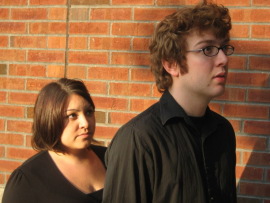 Sarah Ulloa and Ryan Westwood, john & jen. The Green Room's two-character musical found the duo playing sister and brother in the first act and mother and son in the second, and reaffirmed Ulloa's and Westwood's status as two of our area's most thrilling performers. (Both are currently seniors at St. Ambrose University.) Audiences, myself included, may not have known much about this hugely demanding show before the lights dimmed, but after watching Ulloa and Westwood carry it with absolute effortlessness and stirring vocals, it's unlikely we'll ever forget it.
Sarah Ulloa and Ryan Westwood, john & jen. The Green Room's two-character musical found the duo playing sister and brother in the first act and mother and son in the second, and reaffirmed Ulloa's and Westwood's status as two of our area's most thrilling performers. (Both are currently seniors at St. Ambrose University.) Audiences, myself included, may not have known much about this hugely demanding show before the lights dimmed, but after watching Ulloa and Westwood carry it with absolute effortlessness and stirring vocals, it's unlikely we'll ever forget it.
 James Bleecker and Abby Van Gerpen, Jerry Finnegan's Sister. The rom-com flip side to john & jen. Following that show by three weekends, the second of the Green Room's two-person 2008 productions found Bleecker's Brian pining (in indecisive agony) over Van Gerpen's Beth, and the two made for an honest and adorable pair of non-sweethearts; Bleecker was wholly assured as a comically neurotic wreck, and Van Gerpen - similarly outstanding in the venue's Eleemosynary and The Melville Boys this year - provided dizzying fun as a cuddlebug who was far more complex than you, and certainly Brian, ever dreamed.
James Bleecker and Abby Van Gerpen, Jerry Finnegan's Sister. The rom-com flip side to john & jen. Following that show by three weekends, the second of the Green Room's two-person 2008 productions found Bleecker's Brian pining (in indecisive agony) over Van Gerpen's Beth, and the two made for an honest and adorable pair of non-sweethearts; Bleecker was wholly assured as a comically neurotic wreck, and Van Gerpen - similarly outstanding in the venue's Eleemosynary and The Melville Boys this year - provided dizzying fun as a cuddlebug who was far more complex than you, and certainly Brian, ever dreamed.
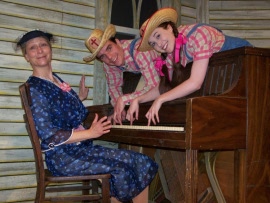 Andrew Crowe and Jenny Stodd, Smoke on the Mountain. Circa '21's gospel comedy was practically overflowing with buoyancy and spirit, and portraying twin musicians Dennis and Denise Sanders, Crowe and Stodd seemed to share a sibling bond that extended far past the boundaries of the (deeply entertaining) script. Exuding delight at the talents their characters have likely been honing since birth, these subtle, graceful performers were forever communicating on some unspoken wavelength, and pulled off the year's most impressive musical parlor trick, offering a first-rate piano duet performed upside-down.
Andrew Crowe and Jenny Stodd, Smoke on the Mountain. Circa '21's gospel comedy was practically overflowing with buoyancy and spirit, and portraying twin musicians Dennis and Denise Sanders, Crowe and Stodd seemed to share a sibling bond that extended far past the boundaries of the (deeply entertaining) script. Exuding delight at the talents their characters have likely been honing since birth, these subtle, graceful performers were forever communicating on some unspoken wavelength, and pulled off the year's most impressive musical parlor trick, offering a first-rate piano duet performed upside-down.
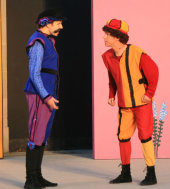
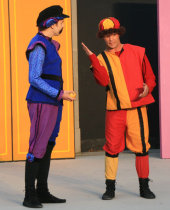 Jonathan Gregoire and Kevin Wender, The Comedy of Errors. More twins! In this Genesius Guild production, Shakespeare's slapstick servants would've been plenty funny through Ellen Dixon's wardrobe selections alone, as each costume was a mirror image of the other. Gregoire and Wender, though, were brilliantly adept at playing mirrored souls, and were so hysterically in-synch physically, temperamentally, and vocally - their shared laugh was a nasally staccato "Heh-heh-heh-heh-heh-heh-heh!" - that it was a true bummer remembering that, at 100 minutes, Comedy of Errors is one of the shortest plays in the Bard's canon. Where's a three-hour running length when you really want one?
Jonathan Gregoire and Kevin Wender, The Comedy of Errors. More twins! In this Genesius Guild production, Shakespeare's slapstick servants would've been plenty funny through Ellen Dixon's wardrobe selections alone, as each costume was a mirror image of the other. Gregoire and Wender, though, were brilliantly adept at playing mirrored souls, and were so hysterically in-synch physically, temperamentally, and vocally - their shared laugh was a nasally staccato "Heh-heh-heh-heh-heh-heh-heh!" - that it was a true bummer remembering that, at 100 minutes, Comedy of Errors is one of the shortest plays in the Bard's canon. Where's a three-hour running length when you really want one?
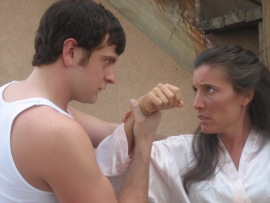 Eddie Staver III and Stephanie Burrough, Stephanie Burrough and Kimberly Furness, Kimberly Furness and Eddie Staver III, A Streetcar Named Desire. I know, this is totally cheating, and ups that "Five Exquisite Pairings" header to "Seven ... ." But while these performers were inspiring in any configuration for Harrison Hilltop's Tennessee Williams drama, they were particularly amazing in their acting couplets: Staver's Stanley and (Reader employee) Burrough's Stella brought incendiary heat, romantic ardor, and exquisite pain to their scenes together; Burrough and Furness, as Blanche DuBois, forged a palpable sisterly union that registered a lifetime of adoration for, and infuriation with, one another; and Furness and Staver danced a delicate pas de deux of flirtation, spite, and emotional hunger ... and did so again three months later in the trenchant two-character drama Danny & the Deep Blue Sea for the Curtainbox Theatre Company. Well, how 'bout that? I guess that makes it "Eight Exquisite Pairings."
Eddie Staver III and Stephanie Burrough, Stephanie Burrough and Kimberly Furness, Kimberly Furness and Eddie Staver III, A Streetcar Named Desire. I know, this is totally cheating, and ups that "Five Exquisite Pairings" header to "Seven ... ." But while these performers were inspiring in any configuration for Harrison Hilltop's Tennessee Williams drama, they were particularly amazing in their acting couplets: Staver's Stanley and (Reader employee) Burrough's Stella brought incendiary heat, romantic ardor, and exquisite pain to their scenes together; Burrough and Furness, as Blanche DuBois, forged a palpable sisterly union that registered a lifetime of adoration for, and infuriation with, one another; and Furness and Staver danced a delicate pas de deux of flirtation, spite, and emotional hunger ... and did so again three months later in the trenchant two-character drama Danny & the Deep Blue Sea for the Curtainbox Theatre Company. Well, how 'bout that? I guess that makes it "Eight Exquisite Pairings."
Five Impressive Debuts
By which I mean: Debuts for me. All five of these talented performers had stage experience prior to the shows I've cited them for, but in each case their portrayals made me - and, I'm guessing, plenty of others in the audience - learn forward, stare a little closer, and say to myself, "Who is that?!" With a big smile.
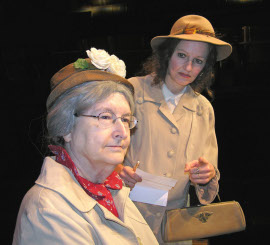 Jean Lupoli, The Trip to Bountiful. Though technically a drama, Playcrafters' production did feature a priceless running gag, which arose whenever characters were asked whether they'd seen or spoken with Lupoli's mean-spirited Jessie Mae. "Yes ... " they'd reply with hilarious fatigue, as if even the memory of her insults and self-aggrandizement was exhausting them. What was excruciating for the play's characters, though, was heavenly for the audience; Lupoli was so strong that her endearingly hateful presence was felt even when off-stage.
Jean Lupoli, The Trip to Bountiful. Though technically a drama, Playcrafters' production did feature a priceless running gag, which arose whenever characters were asked whether they'd seen or spoken with Lupoli's mean-spirited Jessie Mae. "Yes ... " they'd reply with hilarious fatigue, as if even the memory of her insults and self-aggrandizement was exhausting them. What was excruciating for the play's characters, though, was heavenly for the audience; Lupoli was so strong that her endearingly hateful presence was felt even when off-stage.
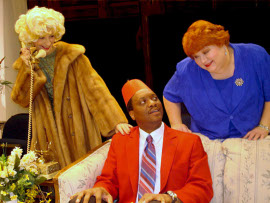 Susan Philhower, Light Up the Sky. Imagine Little Shop of Horrors' Audrey with a platinum card, or Guys & Dolls' Adelaide refusing to give back her mink, and you'll get a good sense of Philhower's comic style in Richmond Hill's February farce. Employing serenely ditzy Noo Yawk cadences, her theatrical producer Frances Black may have seemed empty-headed, but she was really just distracted by the dollar signs dancing in her head, and Philhower - shrewdly alert to the ridiculousness of Frances' presumed inferiors - turned her every sarcastic utterance into a comedic goldmine.
Susan Philhower, Light Up the Sky. Imagine Little Shop of Horrors' Audrey with a platinum card, or Guys & Dolls' Adelaide refusing to give back her mink, and you'll get a good sense of Philhower's comic style in Richmond Hill's February farce. Employing serenely ditzy Noo Yawk cadences, her theatrical producer Frances Black may have seemed empty-headed, but she was really just distracted by the dollar signs dancing in her head, and Philhower - shrewdly alert to the ridiculousness of Frances' presumed inferiors - turned her every sarcastic utterance into a comedic goldmine.
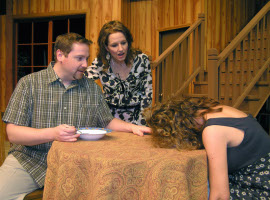 Christopher Tracy, Anybody for Murder?. If any actor had a tougher assignment this year, I'm not sure who it would be. Portraying mild-mannered Max in this Playcrafters comedy, Tracy had to attempt to kill his wife and girlfriend, drug his neighbors, drag a lifeless body up a staircase, lie to characters with nearly every line ... and, in the end, still be likable. Astonishingly, he pulled it off. The script was filled with holes, but Tracy's natural innocence, ironic double takes, and wicked way with a punchline continually covered them up; he made his material play about 10 times better than it had any right to.
Christopher Tracy, Anybody for Murder?. If any actor had a tougher assignment this year, I'm not sure who it would be. Portraying mild-mannered Max in this Playcrafters comedy, Tracy had to attempt to kill his wife and girlfriend, drug his neighbors, drag a lifeless body up a staircase, lie to characters with nearly every line ... and, in the end, still be likable. Astonishingly, he pulled it off. The script was filled with holes, but Tracy's natural innocence, ironic double takes, and wicked way with a punchline continually covered them up; he made his material play about 10 times better than it had any right to.
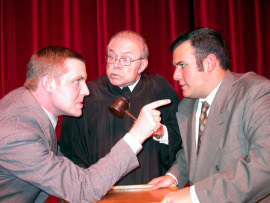 John Hannon, Inherit the Wind. Now a senior, Hannon made his St. Ambrose University acting debut with this October drama. Which begs the question: What the hell has he been doing for the past three years? Like ... studying or something? Hannon was so fine as defense attorney Henry Drummond, so confident and quick-witted and inventive, that he gave this warhorse of a play a true shot in the arm, helping you rediscover its power and eccentric humor. There are two shows left in St. Ambrose's mainstage season, so let's cross our fingers that Hannon will be seen in at least one of them, and won't be too busy, you know, doing schoolwork or whatever ... .
John Hannon, Inherit the Wind. Now a senior, Hannon made his St. Ambrose University acting debut with this October drama. Which begs the question: What the hell has he been doing for the past three years? Like ... studying or something? Hannon was so fine as defense attorney Henry Drummond, so confident and quick-witted and inventive, that he gave this warhorse of a play a true shot in the arm, helping you rediscover its power and eccentric humor. There are two shows left in St. Ambrose's mainstage season, so let's cross our fingers that Hannon will be seen in at least one of them, and won't be too busy, you know, doing schoolwork or whatever ... .
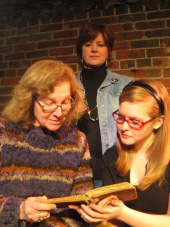 Angela Elliott, Eleemosynary. If my question for Hannon is "Where have you been?", my question for Elliott is "Where have you gone?" Debuting in the Green Room's generational comedy, the recent area transplant was a true find, delivering piquant humor and heartbreak through extraordinarily subtle means; it wasn't just the character, but the performer, who felt perfectly scaled for the venue. Her every reading had a lovely naturalism and appealing rhythm, and after February's Eleemosynary, she went on to appear in ... nothing. Come back, Angela Elliott! Theatre misses you!
Angela Elliott, Eleemosynary. If my question for Hannon is "Where have you been?", my question for Elliott is "Where have you gone?" Debuting in the Green Room's generational comedy, the recent area transplant was a true find, delivering piquant humor and heartbreak through extraordinarily subtle means; it wasn't just the character, but the performer, who felt perfectly scaled for the venue. Her every reading had a lovely naturalism and appealing rhythm, and after February's Eleemosynary, she went on to appear in ... nothing. Come back, Angela Elliott! Theatre misses you!
Five Remarkable Technical Achievements
Outstanding sets, costumes, lights, and sound can occasionally provide a whole evening's entertainment by themselves, and the following five - well, six - shows were notable not only for their superior technical craftsmanship, and for how beautifully the designs served the stories, but for how the tech oftentimes became the story ... and not in a bad way. (Remember Starlight Express? Nah. Me neither.)
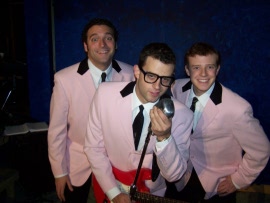 Buddy: The Buddy Holly Story. Productions at Circa '21 can generally be counted on for outstanding technical efforts. Yet scenic designer Phil Hickox, costumer Gregory Hiatt, lighting designer Ron Breedlove, and sound designer Ray Malone did something more than deliver topnotch period deign for this Holly remembrance; they completely set the stage for a blazing, kick-ass '50s rock concert, and did a better job of celebrating the era than the script did. The show's excellent musicians helped, of course, but Buddy's tech was essential to the finale's power, giving you a sense of the youthful hope that was (momentarily) lost even beyond the man and his music.
Buddy: The Buddy Holly Story. Productions at Circa '21 can generally be counted on for outstanding technical efforts. Yet scenic designer Phil Hickox, costumer Gregory Hiatt, lighting designer Ron Breedlove, and sound designer Ray Malone did something more than deliver topnotch period deign for this Holly remembrance; they completely set the stage for a blazing, kick-ass '50s rock concert, and did a better job of celebrating the era than the script did. The show's excellent musicians helped, of course, but Buddy's tech was essential to the finale's power, giving you a sense of the youthful hope that was (momentarily) lost even beyond the man and his music.
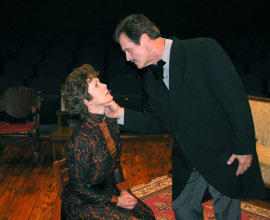 Angel Street. Considering what must be enormous challenges in lighting and designing sets for Richmond Hill's theatre-in-the-round, technical director Jennifer Kingry did superior work for the venue's Victorian thriller. Hell, she did superior work even not considering the challenges, and the play's gorgeous creepiness was further enhanced by Kingry's subtle sound effects and Jean Melillo's stunning costumes, which were as smart as they were detailed. So far as the tech was concerned, my only complaint would be that no one found a way to make the set, lights, sound, and costumes take a bow during the curtain call.
Angel Street. Considering what must be enormous challenges in lighting and designing sets for Richmond Hill's theatre-in-the-round, technical director Jennifer Kingry did superior work for the venue's Victorian thriller. Hell, she did superior work even not considering the challenges, and the play's gorgeous creepiness was further enhanced by Kingry's subtle sound effects and Jean Melillo's stunning costumes, which were as smart as they were detailed. So far as the tech was concerned, my only complaint would be that no one found a way to make the set, lights, sound, and costumes take a bow during the curtain call.
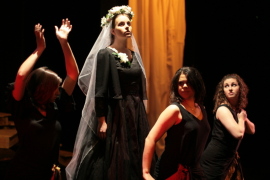 Blood Wedding. It oftentimes didn't feel like you were watching a play during Augustana College's fall drama. It felt like you were watching a painting. That moved. Federico García Lorca's tragedy featured some of the most shivery theatrical imagery and sounds to be experienced anywhere this year - an oppressively ticking clock, a silhouetted duel, an expressionistic wedding dance to fill even the most jubilant with dread - and sound designer Jeff Coussens (who also directed), scenic designers Adam Parboosingh and Andy Gutshall, and costume designer Ellen Dixon all helped make a decidedly un-fun piece an almost embarrassingly enjoyable time.
Blood Wedding. It oftentimes didn't feel like you were watching a play during Augustana College's fall drama. It felt like you were watching a painting. That moved. Federico García Lorca's tragedy featured some of the most shivery theatrical imagery and sounds to be experienced anywhere this year - an oppressively ticking clock, a silhouetted duel, an expressionistic wedding dance to fill even the most jubilant with dread - and sound designer Jeff Coussens (who also directed), scenic designers Adam Parboosingh and Andy Gutshall, and costume designer Ellen Dixon all helped make a decidedly un-fun piece an almost embarrassingly enjoyable time.
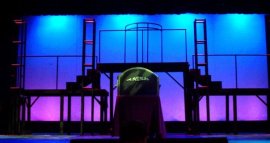 Evita. During the opening 10 minutes of this Music Guild presentation - minutes that featured an astonishing array of visual and audial riches provided by scenic designer C.W. Howard, lighting designers Steve Parmley and Kevin Pierce, sound designer J. Adam Lounsberry, and costume designer Peggy Freeman - I whispered exactly one word to the friend seated next to me: "Wow." From the beautiful and functional set to Eva's continually dazzling wardrobe, this was one of the most eye- and ear-catching Music Guild shows I've ever seen, and would've been a no-contest choice for the guild's best tech of 2008 if it wasn't competing with ...
Evita. During the opening 10 minutes of this Music Guild presentation - minutes that featured an astonishing array of visual and audial riches provided by scenic designer C.W. Howard, lighting designers Steve Parmley and Kevin Pierce, sound designer J. Adam Lounsberry, and costume designer Peggy Freeman - I whispered exactly one word to the friend seated next to me: "Wow." From the beautiful and functional set to Eva's continually dazzling wardrobe, this was one of the most eye- and ear-catching Music Guild shows I've ever seen, and would've been a no-contest choice for the guild's best tech of 2008 if it wasn't competing with ...
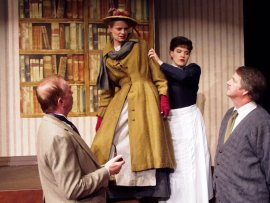 My Fair Lady. I mean, come on. Those staggering costumes by Deb Holmes, which must've totaled upwards of 100? Those lighting designs by Ryan Mandle, which effectively conveyed both squalor and unspeakable wealth? The sound design by Sean McGinn, which made the vocalists' and the marvelous orchestra's output sound clear as crystal? That set by director Kevin Pieper, with those background flats that effortlessly transformed into Henry Higgins' room ... complete with fully functional staircases?! Music Guild could've tripled the ticket price for My Fair Lady and audiences still would've gotten a bargain.
My Fair Lady. I mean, come on. Those staggering costumes by Deb Holmes, which must've totaled upwards of 100? Those lighting designs by Ryan Mandle, which effectively conveyed both squalor and unspeakable wealth? The sound design by Sean McGinn, which made the vocalists' and the marvelous orchestra's output sound clear as crystal? That set by director Kevin Pieper, with those background flats that effortlessly transformed into Henry Higgins' room ... complete with fully functional staircases?! Music Guild could've tripled the ticket price for My Fair Lady and audiences still would've gotten a bargain.
And a Show Deserving a Tech Mention All Its Own
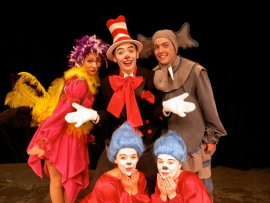 Seussical Jr. At the start of St. Ambrose University's recent family musical, we first saw performer Jessica Denney, a bed, and not much else. But then the Cat in the Hat's famously striped chapeau dropped from the ceiling, and landed square in the middle of the bed - a pretty neat trick. But then, in one the most astonishing stage entrances I've ever seen, Sean Tweedale's Cat in the Hat arrived by bursting through the bed, and within seconds - like five seconds - the near-bare stage was transformed into a brilliantly colorful and imaginative universe, one that suggested what a book-fueled youth would come up with if asked to design the best amusement park ever. There's no way to adequately describe the visual wonders Seussical Jr. provided, but for the show's hour-long running time, they almost never ceased; following the performance, you didn't want to thank the designers so much as propose to them. Barring that, and since I didn't have the chance to review the production previously, allow me to offer a hearty congratulations to director/choreographer Shellee Frazee and the show's extraordinary visual wizards - lighting designer Eric Behnke and the utterly invaluable Dianne Dye (costume designer) and Kristofer Eitrheim (set designer and technical director) - for area theatre's playground of the year. No wonder the cast looked so happy.
Seussical Jr. At the start of St. Ambrose University's recent family musical, we first saw performer Jessica Denney, a bed, and not much else. But then the Cat in the Hat's famously striped chapeau dropped from the ceiling, and landed square in the middle of the bed - a pretty neat trick. But then, in one the most astonishing stage entrances I've ever seen, Sean Tweedale's Cat in the Hat arrived by bursting through the bed, and within seconds - like five seconds - the near-bare stage was transformed into a brilliantly colorful and imaginative universe, one that suggested what a book-fueled youth would come up with if asked to design the best amusement park ever. There's no way to adequately describe the visual wonders Seussical Jr. provided, but for the show's hour-long running time, they almost never ceased; following the performance, you didn't want to thank the designers so much as propose to them. Barring that, and since I didn't have the chance to review the production previously, allow me to offer a hearty congratulations to director/choreographer Shellee Frazee and the show's extraordinary visual wizards - lighting designer Eric Behnke and the utterly invaluable Dianne Dye (costume designer) and Kristofer Eitrheim (set designer and technical director) - for area theatre's playground of the year. No wonder the cast looked so happy.
Five Relative Shockers
Plenty of theatrical occurrences surprised the hell out of me this year: The implied violence in Abel's murder during Countryside Community Theatre's Children of Eden; the juicily convincing executions in the Clinton Showboat's Sweeney Todd; the fact that I made it through not one but two Neil Simon pieces without wanting to kill myself. (With apologies to the third.) And the following five productions also contained their share of wonderfully eyebrow-raising moments.
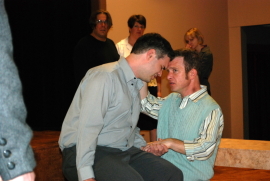 The Merchant of Venice. Shakespeare purists might've griped, and not without reason, about the liberties taken in this Prenzie Players production. But when, within the show's first few minutes, the subtextual romantic entanglement between Andy Koski's Antonio and J.C. Luxton's Bassanio was made quite obvious - via some enthusiastic action on a strategically placed couch - you were surprised not just by this newly overt relationship, but by how dramatically (and subversively) it made you re-think the Bard's entire play.
The Merchant of Venice. Shakespeare purists might've griped, and not without reason, about the liberties taken in this Prenzie Players production. But when, within the show's first few minutes, the subtextual romantic entanglement between Andy Koski's Antonio and J.C. Luxton's Bassanio was made quite obvious - via some enthusiastic action on a strategically placed couch - you were surprised not just by this newly overt relationship, but by how dramatically (and subversively) it made you re-think the Bard's entire play.
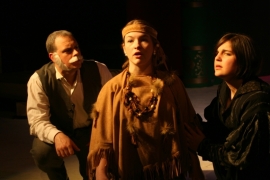 Romance Language. Watching characters of the same sex kissing on area stages will, I'm assuming, gradually lose its novelty. But what won't ever be less than astounding - because it's astounding when it happens with straight characters, too - is when gay relationships are explored and enacted with true passion, emotion, and tenderness, and Augustana College's Kyle Roggenbuck, Katie Wyant, Kevin Wender, and Justin Schaller (achingly soulful here as a Wild West transvestite) were fearless about exposing the hidden desires that drove their haunted figures.
Romance Language. Watching characters of the same sex kissing on area stages will, I'm assuming, gradually lose its novelty. But what won't ever be less than astounding - because it's astounding when it happens with straight characters, too - is when gay relationships are explored and enacted with true passion, emotion, and tenderness, and Augustana College's Kyle Roggenbuck, Katie Wyant, Kevin Wender, and Justin Schaller (achingly soulful here as a Wild West transvestite) were fearless about exposing the hidden desires that drove their haunted figures.
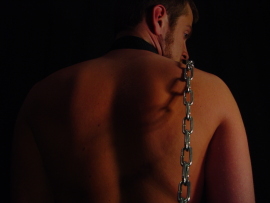 Life's a Dream. One of Eddie Staver III's acting gifts is that he nearly always appears emotionally naked on stage. In this Prenzie Players take on Pedro Calderón's classic, he was oftentimes required to be physically naked, as well. As the man-beast Sigesmund, Staver's scenes in his jail cell were ferociously daring, but there was nothing tawdry about his costume-less stunt; the actor made such an imploring connection with his audience and fellow performers that it's doubtful anyone was looking anywhere but into his eyes.
Life's a Dream. One of Eddie Staver III's acting gifts is that he nearly always appears emotionally naked on stage. In this Prenzie Players take on Pedro Calderón's classic, he was oftentimes required to be physically naked, as well. As the man-beast Sigesmund, Staver's scenes in his jail cell were ferociously daring, but there was nothing tawdry about his costume-less stunt; the actor made such an imploring connection with his audience and fellow performers that it's doubtful anyone was looking anywhere but into his eyes.
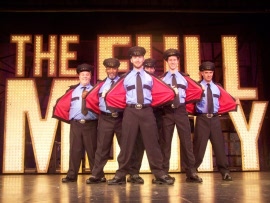 The Full Monty. Interestingly, not everyone was thrilled with Circa '21's decision to stage this glorious, big-hearted, and admittedly racy musical. (I gleaned this after receiving an unsigned letter decrying this "garbage" and "trash," complete with the capitalized query "WHERE HAVE OUR MORALS AND VALUES GONE???") But while the rough language and gay characters and rear nudity were, for the venue, a considerable surprise, Circa pulled the show off with sensational style, skill, and, most importantly, empathy, and I'm hoping the venue continues to take occasional chances of this sort without fear of audience reprisal. I'm betting that most of the dinner theatre's audiences, whether they approved of the show or not, still had an appetite for dessert.
The Full Monty. Interestingly, not everyone was thrilled with Circa '21's decision to stage this glorious, big-hearted, and admittedly racy musical. (I gleaned this after receiving an unsigned letter decrying this "garbage" and "trash," complete with the capitalized query "WHERE HAVE OUR MORALS AND VALUES GONE???") But while the rough language and gay characters and rear nudity were, for the venue, a considerable surprise, Circa pulled the show off with sensational style, skill, and, most importantly, empathy, and I'm hoping the venue continues to take occasional chances of this sort without fear of audience reprisal. I'm betting that most of the dinner theatre's audiences, whether they approved of the show or not, still had an appetite for dessert.
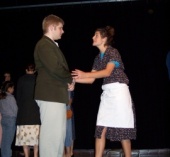 The Lottery. Paired with The Summer People, Scott Community College's evening of Shirley Jackson one-acts delivered 75 minutes of giggly-spooky fun. But in an evocative, sick-joke addition to the author's original short story, The Lottery's Bill Hutchison (played by Patrick Joslyn) mentions that not all of his family's members will be taking part in this year's ritual, as one of their kin "died when he was a baby." It's never referenced again, but the moment's terror lingers. Oh my God, you thought. Did these nutjobs actually stone to death an infant?!?
The Lottery. Paired with The Summer People, Scott Community College's evening of Shirley Jackson one-acts delivered 75 minutes of giggly-spooky fun. But in an evocative, sick-joke addition to the author's original short story, The Lottery's Bill Hutchison (played by Patrick Joslyn) mentions that not all of his family's members will be taking part in this year's ritual, as one of their kin "died when he was a baby." It's never referenced again, but the moment's terror lingers. Oh my God, you thought. Did these nutjobs actually stone to death an infant?!?
Five Unexpected (and Happy) Accidents
One of the many joys of theatre, of course, it that it's live; on any given night, anything can happen. And on the days I attended the following five productions, anything did, lending the shows an unanticipated burst (or several) of added spontaneity.
 Catch Me If You Can. Opening night for Richmond Hill's mystery was preceded by an announcement from director Kevin DeDecker, who informed us that actor Mike Skiles (who has since recovered nicely) had fallen ill, and that stage manager Drew Carter - script in hand, and with no previous stage experience - would be covering for him. Yet what could've been an unbearably awkward evening instead turned into a terrifically enjoyable one, as Carter handled the staging with ease, and displayed so much natural comic instinct - and such a smart way with a tossed-off punchline - that he engendered not just empathy, but gratitude.
Catch Me If You Can. Opening night for Richmond Hill's mystery was preceded by an announcement from director Kevin DeDecker, who informed us that actor Mike Skiles (who has since recovered nicely) had fallen ill, and that stage manager Drew Carter - script in hand, and with no previous stage experience - would be covering for him. Yet what could've been an unbearably awkward evening instead turned into a terrifically enjoyable one, as Carter handled the staging with ease, and displayed so much natural comic instinct - and such a smart way with a tossed-off punchline - that he engendered not just empathy, but gratitude.
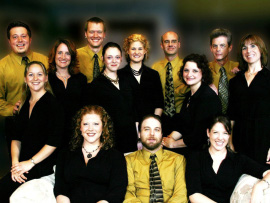 Vaudeville. On the day I attended Circa '21's performing-wait-staff revue, I received a call saying that Bootlegger Sarahjayne Snow (who has since recovered nicely) had broken her leg, and that her co-workers would be covering songs and dances in her absence. Snow eventually returned to the production, but opening night found Liz J. Millea, Sunshine Ramsey, and Bryan Spies nailing her solos with just a few hours' notice, choreography subtly adjusted for 12 instead of 13, and everyone on stage making these feats look like the simplest tasks on earth. Which is what Bootleggers are supposed to do. I was so proud.
Vaudeville. On the day I attended Circa '21's performing-wait-staff revue, I received a call saying that Bootlegger Sarahjayne Snow (who has since recovered nicely) had broken her leg, and that her co-workers would be covering songs and dances in her absence. Snow eventually returned to the production, but opening night found Liz J. Millea, Sunshine Ramsey, and Bryan Spies nailing her solos with just a few hours' notice, choreography subtly adjusted for 12 instead of 13, and everyone on stage making these feats look like the simplest tasks on earth. Which is what Bootleggers are supposed to do. I was so proud.
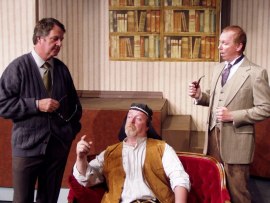 My Fair Lady. Every summer, it seems, finds me at one venue during a torrential rainstorm that messes with the proceedings, and Music Guild's Prospect Park Auditorium was the "winner" for 2008. (Better to have rain at this Guild show than a Genesius Guild show, I suppose.) The performers did an expert job of singing over the violent thunderclaps, but were even more impressive when, late in Act II, the storm knocked out the power completely. Without stage lights or working body mics, the cast soldiered on as if they hadn't even noticed the outage; they stayed in thorough character and merely projected, and were eventually rewarded with the electricity's return. And our sincere, and impressed, appreciation.
My Fair Lady. Every summer, it seems, finds me at one venue during a torrential rainstorm that messes with the proceedings, and Music Guild's Prospect Park Auditorium was the "winner" for 2008. (Better to have rain at this Guild show than a Genesius Guild show, I suppose.) The performers did an expert job of singing over the violent thunderclaps, but were even more impressive when, late in Act II, the storm knocked out the power completely. Without stage lights or working body mics, the cast soldiered on as if they hadn't even noticed the outage; they stayed in thorough character and merely projected, and were eventually rewarded with the electricity's return. And our sincere, and impressed, appreciation.
 The Taming of the Shrew. Prenzie Players offerings frequently open with a half-hour "pre-show" in which you're shown what characters are up to in the 30 minutes prior to the first words of text. For March's Shakespeare comedy, the play was preceded by an open-mic event - included to help explain Christopher Sly's drunkenness - in which actors and audience members were invited to share a song or a reading. And while the show's opening night was filled with hilarious moments, I'm not sure any topped the monologue delivered by Andy Koski, who enacted a tonally perfect interpretation of ... Keanu Reeves in Johnny Mnemonic. "Whoa," indeed.
The Taming of the Shrew. Prenzie Players offerings frequently open with a half-hour "pre-show" in which you're shown what characters are up to in the 30 minutes prior to the first words of text. For March's Shakespeare comedy, the play was preceded by an open-mic event - included to help explain Christopher Sly's drunkenness - in which actors and audience members were invited to share a song or a reading. And while the show's opening night was filled with hilarious moments, I'm not sure any topped the monologue delivered by Andy Koski, who enacted a tonally perfect interpretation of ... Keanu Reeves in Johnny Mnemonic. "Whoa," indeed.
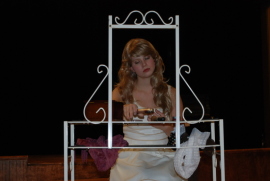 The Merchant of Venice. October's Prenzie Players production, meanwhile, unofficially began with Koski and fellow actor Stephanie Moeller standing outside the Village Theatre, begging passers-by to boycott the evening's performance. (The production's profanity and gay relationship, their characters insisted, were in very poor taste.) On my way into the venue, the duo came up to me and initiated a debate on theatrical propriety. I happily played along. And afterwards, I spent five minutes fielding questions from two fellow attendees convinced that the stunt was real, with one gentleman stating that if this closed-minded pair had approached him, "I would've given them a piece of my mind!" Man, I love theatre.
The Merchant of Venice. October's Prenzie Players production, meanwhile, unofficially began with Koski and fellow actor Stephanie Moeller standing outside the Village Theatre, begging passers-by to boycott the evening's performance. (The production's profanity and gay relationship, their characters insisted, were in very poor taste.) On my way into the venue, the duo came up to me and initiated a debate on theatrical propriety. I happily played along. And afterwards, I spent five minutes fielding questions from two fellow attendees convinced that the stunt was real, with one gentleman stating that if this closed-minded pair had approached him, "I would've given them a piece of my mind!" Man, I love theatre.

